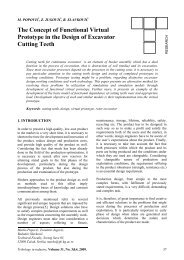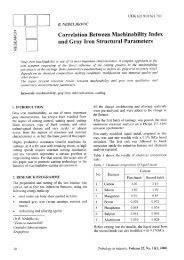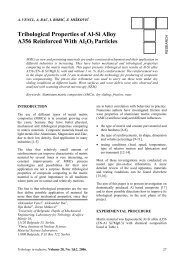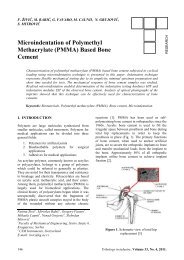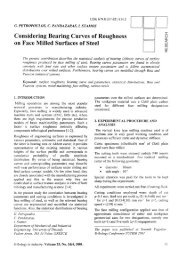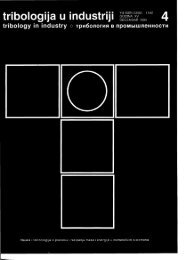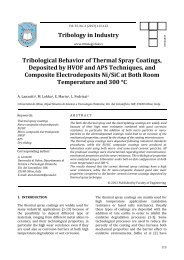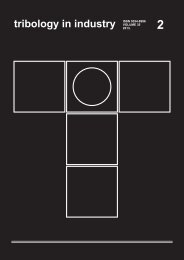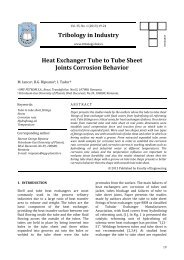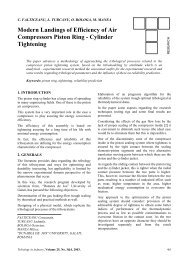The Initial Estimate of the Useful Lifetime of the Oil in Diesel Engines ...
The Initial Estimate of the Useful Lifetime of the Oil in Diesel Engines ...
The Initial Estimate of the Useful Lifetime of the Oil in Diesel Engines ...
Create successful ePaper yourself
Turn your PDF publications into a flip-book with our unique Google optimized e-Paper software.
Vol. 35, No. 1 (2013) 61‐68Tribology <strong>in</strong> Industrywww.tribology.f<strong>in</strong>k.rsRESEARCH<strong>The</strong> <strong>Initial</strong> <strong>Estimate</strong> <strong>of</strong> <strong>the</strong> <strong>Useful</strong> <strong>Lifetime</strong> <strong>of</strong> <strong>the</strong> <strong>Oil</strong><strong>in</strong> <strong>Diesel</strong> Eng<strong>in</strong>es Us<strong>in</strong>g <strong>Oil</strong> AnalysisS.A. Adnani a , S.J. Hashemi b , A. Shooshtari c , M.M. Attar da Department <strong>of</strong> Eng<strong>in</strong>eer<strong>in</strong>g, Hamedan Branch, Islamic Azad University, Science and Research Campus, Hamedan, Iran.b Petroleum University <strong>of</strong> Technology, Department <strong>of</strong> Eng<strong>in</strong>eer<strong>in</strong>g, Iran.c Bu‐Ali S<strong>in</strong>a University, Department <strong>of</strong> Eng<strong>in</strong>eer<strong>in</strong>g, Iran.d Department <strong>of</strong> Mechanics, Hamedan Branch, Islamic Azad University, Hamedan, Iran.Keywords:<strong>Diesel</strong> eng<strong>in</strong>e<strong>Oil</strong> analysis<strong>Oil</strong> life<strong>Oil</strong> propertiesWearCorrespond<strong>in</strong>g author:S.A. AdnaniDepartment <strong>of</strong> Eng<strong>in</strong>eer<strong>in</strong>g,Hamedan branch, Islamic AzadUniversity, Science and ResearchCampus, Hamedan, IranE‐mail: ah_adnani@yahoo.comA B S T R A C TIn this paper <strong>the</strong> <strong>Initial</strong> lifetime <strong>of</strong> <strong>the</strong> lubricat<strong>in</strong>g oil <strong>in</strong> 70 <strong>Diesel</strong>eng<strong>in</strong>es model E6‐350 ECONODYNE 4VH has been estimated us<strong>in</strong>g oilanalysis. <strong>The</strong> eng<strong>in</strong>es have been <strong>in</strong>stalled on <strong>the</strong> super heavy vehicles. Thismethod is used to change <strong>the</strong> used oil based on oil operat<strong>in</strong>g hours,odometer and tak<strong>in</strong>g samples before that. Next, <strong>the</strong> samples are sent to <strong>the</strong>laboratory for analysis and obta<strong>in</strong><strong>in</strong>g <strong>the</strong> results. In order to be able todeterm<strong>in</strong>e <strong>the</strong> overall condition <strong>of</strong> <strong>the</strong> eng<strong>in</strong>e, we have to study variousparameters, such as wear elements, pollutants, elements correlationcoefficients, viscosity, base number, acid number, type and <strong>the</strong> amount <strong>of</strong>eng<strong>in</strong>e wear <strong>in</strong> <strong>the</strong> same condition <strong>of</strong> <strong>the</strong> eng<strong>in</strong>e model, oil consumption andoperat<strong>in</strong>g condition and <strong>the</strong>refore, <strong>the</strong> useful oil life is determ<strong>in</strong>ed (100hours). At last, a formula for silicon and alum<strong>in</strong>um elements is found. If <strong>the</strong>number <strong>of</strong> samples <strong>in</strong>creases <strong>the</strong>n <strong>the</strong> error rate will be reduced. So, <strong>the</strong>results are only based on <strong>the</strong> number <strong>of</strong> taken samples.© 2013 Published by Faculty <strong>of</strong> Eng<strong>in</strong>eer<strong>in</strong>g1. INTRODUCTIONToday, mach<strong>in</strong>es and equipment conditionmonitor<strong>in</strong>g through oil analysis as a method <strong>of</strong>effective ma<strong>in</strong>tenance program is known.Never<strong>the</strong>less, <strong>the</strong> application <strong>of</strong> this technology to<strong>the</strong> various types <strong>of</strong> <strong>in</strong>dustry and user equipmentis still very broad to a certa<strong>in</strong> extent [1].<strong>The</strong> best performance eng<strong>in</strong>e oil is important <strong>in</strong>two aspects: 1) <strong>the</strong> economy 2) <strong>in</strong> terms <strong>of</strong> itseffect on eng<strong>in</strong>e life. <strong>The</strong> economic aspectsshould be emphasized <strong>the</strong> probability that <strong>the</strong>eng<strong>in</strong>e oil should be changed sooner is very highand it is not economically. On <strong>the</strong> o<strong>the</strong>r hand, itmay be late to oil change because this is <strong>the</strong>probable cause eng<strong>in</strong>e damage and wear. So, <strong>the</strong>use <strong>of</strong> oil analysis is <strong>the</strong> best method forachiev<strong>in</strong>g this goal. Among <strong>the</strong> important factorsthat could affect <strong>the</strong> oil life reduction as follows: Improper storage and contam<strong>in</strong>ationbefore use, Incorrect oil selection and mixed oils thatare not compatible with each o<strong>the</strong>r (forexample, when overflow),61
S.A. Adnani et al., Tribology <strong>in</strong> Industry Vol. 35, No. 1 (2013) 61‐68 Lack <strong>of</strong> adequate consumer appliances (airfilter, oil filter and etc.), Fuel, water and dust contam<strong>in</strong>ations, Not regulated eng<strong>in</strong>e, Existence <strong>of</strong> excessive metal particles <strong>in</strong> oil, <strong>Oil</strong> clean reduction <strong>in</strong> sensitive mechanicalsystems (turb<strong>in</strong>es, compressors andhydraulic) [2].2. ENGINES SPECIFICATIONS Model: E6‐350 ECONODYNE 4VH Horsepower maximum BHP@1800 rpm:350 (261 Kw) Compression Ratio (pressure@1000 rpm):15:1(31.72 bar) Bore & Stroke: 123.8 mm × 152.4 mm Cyl<strong>in</strong>der: 6 Year: 1990 Manufactured by Mack Co. <strong>in</strong> U.S.A [3].3. EXPERIMENTAL WORKSampl<strong>in</strong>g procedure has been done whenchang<strong>in</strong>g <strong>the</strong> eng<strong>in</strong>e oil and after laboratory tests,test results have been evaluated (see Table 1).Table 1. <strong>The</strong> number <strong>of</strong> eng<strong>in</strong>es and samples.Tested eng<strong>in</strong>es70Table 2. <strong>The</strong> new oil properties [4].<strong>Oil</strong> nameManufacturerPerformance grade(API)Grade (SAE)T.B.N (mgKOH/g)T.A.N (mgKOH/g)Viscosity <strong>in</strong>dex(M<strong>in</strong>)Viscosity at 40 ° C (cSt)Viscosity at 100 ° C (cSt)Open flash po<strong>in</strong>t (° C)<strong>Oil</strong> samples number160SepahanGenerator speedyCD/SF4014.51.199163.9115.84241Sampl<strong>in</strong>g has been done so that each eng<strong>in</strong>e hasbeen sampled <strong>in</strong> two or three times. S<strong>in</strong>ce alleng<strong>in</strong>es have <strong>the</strong> same oil, model and workconditions, so variables are low. If oil samples<strong>in</strong>creases, errors <strong>in</strong> results will be less. In additionto <strong>the</strong> regular test and verification <strong>of</strong> new oil,specifications <strong>in</strong> terms <strong>of</strong> quality and standards <strong>of</strong><strong>the</strong> new oil have been tested <strong>in</strong> accordance withTable 2. <strong>The</strong> results are based on <strong>the</strong> number <strong>of</strong>oil samples <strong>in</strong> accordance with Table 1.4. OIL USEFUL LIFE ESTIMATIONFor eng<strong>in</strong>e oil life estimation, items should<strong>in</strong>clude physical and chemical properties <strong>of</strong> oil,such as acid number, base number, viscosity, oilpollution, and wear parameters can be analyzedat various functions. <strong>The</strong>n we should compare<strong>the</strong> figures obta<strong>in</strong>ed from physical and chemicalproperties <strong>of</strong> oil. As we know, <strong>the</strong> new oilproperties go away from its ideal operat<strong>in</strong>gconditions and <strong>in</strong>curred loss. So <strong>in</strong> first step, weevaluate <strong>the</strong> wear and pollutants elements thatplay important role <strong>in</strong> oil life reduction.4.1 Wear elementsMetallic particles <strong>in</strong> eng<strong>in</strong>e oil are ma<strong>in</strong>ly due towear. If wear rate arises <strong>the</strong>n <strong>the</strong> rate <strong>of</strong> metal<strong>in</strong> <strong>the</strong> oil will be higher. <strong>The</strong> most wearelements and <strong>the</strong>ir orig<strong>in</strong>s are accord<strong>in</strong>g toTable 3 [5]:Table 3. Wear elements and orig<strong>in</strong>s [2,6].WearelementsFeCrAlCuPbOrig<strong>in</strong>sCyl<strong>in</strong>der bush – Piston r<strong>in</strong>gs –P<strong>in</strong>s –Cyl<strong>in</strong>der block – NutsR<strong>in</strong>gs – L<strong>in</strong>ers – Valves – Cool<strong>in</strong>gsystemCyl<strong>in</strong>der – Piston – BlowersPiston p<strong>in</strong> bushes – Crank case – <strong>Oil</strong>coolerBear<strong>in</strong>gs4.2 Determ<strong>in</strong>ation <strong>of</strong> maximum concentrationlimit for wear elementsTo determ<strong>in</strong>e <strong>the</strong> limit <strong>of</strong> wear, pollution andsilicon boundary between normal and abnormalwear on eng<strong>in</strong>e components, <strong>the</strong> formula for <strong>the</strong>standard deviation formula (1) can be used:σ = S.D. = (1)Where σ, <strong>the</strong> standard deviation values, Xi, wearand pollutant elements, μ, wear and pollutantelement values, N, <strong>the</strong> number <strong>of</strong> values [1].Accord<strong>in</strong>g to oil analysis results, we can have<strong>the</strong> data on Table 4.62
S.A. Adnani et al., Tribology <strong>in</strong> Industry Vol. 35, No. 1 (2013) 61‐68Table 6. Warn<strong>in</strong>g border for wear elements.Elements and pollutantsFeAlCrCuPbSiWarn<strong>in</strong>g border100100100100100100Here, wear elements <strong>of</strong> oil were studied. But <strong>in</strong>addition to <strong>the</strong>se cases, <strong>the</strong> properties <strong>of</strong> <strong>the</strong> oilplay ma<strong>in</strong> role <strong>in</strong> oil life. That is why <strong>in</strong> this step,we will study <strong>the</strong> physical and chemicalproperties <strong>of</strong> <strong>the</strong> oil.<strong>in</strong>vestigate <strong>the</strong> viscosity <strong>of</strong> <strong>the</strong> oil <strong>in</strong> different hoursand conditions. Accord<strong>in</strong>g to (Fig. 9), <strong>the</strong> viscosity <strong>of</strong>oil decl<strong>in</strong>ed from 164 cSt. In normal conditions, i.e.without pollutants, due to <strong>the</strong> <strong>in</strong>crease <strong>in</strong> oil hour,viscosity trend has become decreased andapproximately rema<strong>in</strong>s at 150 cSt. But <strong>the</strong> greatestloss <strong>of</strong> viscosity is after 120 hours. In (Fig. 10), <strong>the</strong>viscosity <strong>of</strong> <strong>the</strong> oil due to <strong>the</strong> presence <strong>of</strong> <strong>the</strong>contam<strong>in</strong>ant is 150 cSt. Up to 200 hours, maximumviscosity loss is seen. So, 120 hours is determ<strong>in</strong>ed aswarn<strong>in</strong>g border for viscosity.4.5 Wear <strong>in</strong>dexOne <strong>of</strong> <strong>the</strong> most important factors <strong>in</strong> eng<strong>in</strong>ewear is wear <strong>in</strong>dex <strong>of</strong> iron particles <strong>in</strong> oil socalled P.Q. [2]. Accord<strong>in</strong>g to (Fig. 8), with<strong>in</strong>creas<strong>in</strong>g operat<strong>in</strong>g hours, iron particles havealso <strong>in</strong>creased. Accord<strong>in</strong>g to focal po<strong>in</strong>ts, up to150 hours, po<strong>in</strong>ts are separated from each o<strong>the</strong>rand even we see po<strong>in</strong>ts that reached to 250ppm. This matter <strong>in</strong>dicates sudden <strong>in</strong>crease <strong>in</strong><strong>the</strong> number <strong>of</strong> iron particles. So, 150 hours isdeterm<strong>in</strong>ed as an warn<strong>in</strong>g border for P.Q, So atthis step, we <strong>in</strong>vestigate o<strong>the</strong>r oil properties.Fig. 9. Operat<strong>in</strong>g hours and viscosity withoutpollution.Fig. 10. Operat<strong>in</strong>g hours and viscosity with pollution.4.7 Base numberFig. 8. <strong>The</strong> variation <strong>of</strong> wear rate on eng<strong>in</strong>es.Base number is a k<strong>in</strong>d <strong>of</strong> oil properties. Byreduc<strong>in</strong>g <strong>the</strong> oil base number, oil ability <strong>in</strong> <strong>the</strong> face<strong>of</strong> acid enter<strong>in</strong>g from combustion get weak. It<strong>in</strong>dicates <strong>the</strong> need to replace or add new oil[1,2,10,11]. On <strong>the</strong> base <strong>of</strong> tested samples, oil basenumbers <strong>in</strong> different status were evaluated and<strong>the</strong> results are <strong>in</strong> accordance with Fig. 11.4.6 ViscosityViscosity as a one <strong>of</strong> oil properties, affect onreduction <strong>of</strong> bear<strong>in</strong>gs friction and oil film thickness.<strong>The</strong>refore, evaluation <strong>of</strong> viscosity <strong>in</strong> oil analysisprogram is sensitive. Any change <strong>in</strong> <strong>the</strong> viscosity <strong>of</strong><strong>the</strong> lubricant <strong>in</strong>dicates oil degradation, <strong>the</strong> presence<strong>of</strong> <strong>the</strong>rmal stresses <strong>in</strong> <strong>the</strong> oil and oxidation [1,9]. Soafter analyz<strong>in</strong>g <strong>the</strong> wear <strong>in</strong>dex, we desire toFig. 11. Operat<strong>in</strong>g hours and base number.65
S.A. Adnani et al., Tribology <strong>in</strong> Industry Vol. 35, No. 1 (2013) 61‐68Accord<strong>in</strong>g to <strong>the</strong> (Fig. 11), standard limit <strong>of</strong> basenumber is 14.5 mg (KOH) but maximum loss is 7.5mg (KOH) and it is happened on 160 hours. It isvery natural because with <strong>in</strong>creas<strong>in</strong>g operat<strong>in</strong>ghours, oil properties and its life losses. So by<strong>in</strong>creas<strong>in</strong>g operat<strong>in</strong>g hours, <strong>the</strong> oil life decreasedas a result <strong>of</strong> oil properties. So, 120 hours isdeterm<strong>in</strong>ed as a warn<strong>in</strong>g border for base number.4.8 Acid numberAcid number is a k<strong>in</strong>d <strong>of</strong> oil properties that is usedfor <strong>in</strong>dustrial oil. Acid number is used formeasur<strong>in</strong>g <strong>of</strong> oil acidity. Increas<strong>in</strong>g acid value<strong>in</strong>dicates <strong>the</strong> end <strong>of</strong> <strong>the</strong> useful life <strong>of</strong> oil and itsreplacement is necessary. Acid value higher than4 mg (KOH) is highly corrosive and bear<strong>in</strong>gs ando<strong>the</strong>r metal substances can be <strong>in</strong>vaded [1,2,11].Accord<strong>in</strong>g to (Fig. 12), with <strong>in</strong>creas<strong>in</strong>g operat<strong>in</strong>ghours, <strong>the</strong> amount <strong>of</strong> acid number has also<strong>in</strong>creased. Accord<strong>in</strong>g to focal po<strong>in</strong>ts, up to 180hours, <strong>the</strong> acid number has exceeded its limit (4mg (KOH)). So, 180 hours is determ<strong>in</strong>ed as awarn<strong>in</strong>g border for acid number.Table 7. Warn<strong>in</strong>g border for oil properties.<strong>Oil</strong> propertiesBase numberAcid numberViscosityP.QWarn<strong>in</strong>g boundary120 hours180 hours120 hours150 hours4.9 <strong>The</strong> eng<strong>in</strong>e oil life <strong>in</strong> kilometerNow we <strong>in</strong>tend to equivalency <strong>the</strong> oil by o<strong>the</strong>rfactors such as <strong>the</strong> amount <strong>of</strong> kilometer unit,kilometers were recorded at each sampl<strong>in</strong>g.Accord<strong>in</strong>g to <strong>the</strong> Figs. 13 to 15, we can alsoestimate oil life <strong>in</strong> hour and kilometer. S<strong>in</strong>ce <strong>the</strong>operation <strong>of</strong> heavy vehicles <strong>in</strong> terms <strong>of</strong> workplaceis different, so we classify vehicles <strong>in</strong>tothree categories respectively, "Tandem","Keshande" and "Jean Paul".4.10 "Tandem" eng<strong>in</strong>eFigure 13 shows <strong>the</strong> correlation betweenoperat<strong>in</strong>g hours and <strong>the</strong> distance traveled by<strong>the</strong> vehicle "Tandem". This vehicles move <strong>in</strong> alimited area. As <strong>in</strong> previous discussions <strong>of</strong> <strong>the</strong>oil life was 100 hours, now, with respect to (Fig.13), we want to get <strong>the</strong> maximum distancetraveled by vehicle after 100 hours. So 100hours is equal to 3000 km.Fig. 12. Operat<strong>in</strong>g hours and acid number.So, <strong>the</strong> properties <strong>of</strong> <strong>the</strong> oil and itscorrespond<strong>in</strong>g warn<strong>in</strong>g limits can besummarized as described <strong>in</strong> Table 7.At this stage <strong>of</strong> <strong>the</strong> <strong>in</strong>vestigation carried out onerosion, pollution, and f<strong>in</strong>ally <strong>the</strong> physical andchemical properties <strong>of</strong> oil and accord<strong>in</strong>g to <strong>the</strong>results <strong>in</strong> Table 6 and 7, and based on <strong>the</strong>number <strong>of</strong> samples, look carefully and errors,<strong>in</strong>itial eng<strong>in</strong>e oil life is estimated 100 hours.Based on figures obta<strong>in</strong>ed after 100 hours, wecan see <strong>the</strong> presence <strong>of</strong> contam<strong>in</strong>ants, <strong>the</strong>sudden drop <strong>in</strong> oil properties and wear oneng<strong>in</strong>e parts and it is necessary to oil change.Fig. 13. Operat<strong>in</strong>g hours and distance.4.11 "Keshande" eng<strong>in</strong>eAccord<strong>in</strong>g to data from oil analysis, Fig. 14shows <strong>the</strong> relationship between distancetraveled by <strong>the</strong>se vehicles and operat<strong>in</strong>ghours. It is worth mention<strong>in</strong>g that <strong>the</strong>sevehicles are more mobile and have roadtraffic. <strong>The</strong>refore, accord<strong>in</strong>g to <strong>the</strong> 100 hours,<strong>the</strong> maximum distance traveled by <strong>the</strong>sevehicles is 5,900 km.66
S.A. Adnani et al., Tribology <strong>in</strong> Industry Vol. 35, No. 1 (2013) 61‐68 <strong>Oil</strong> laboratory equipment error Error <strong>in</strong> <strong>the</strong> type <strong>of</strong> oil used <strong>in</strong> an eng<strong>in</strong>e oil(two types)Fig. 14. Operat<strong>in</strong>g hours and distance.4.12 "Jean paul" eng<strong>in</strong>eBased on data from oil analysis, Fig. 15 is obta<strong>in</strong>ed.This vehicles move <strong>in</strong> a limited area. Based onpo<strong>in</strong>ts <strong>in</strong> (Fig. 15), for 100 hours, maximumdistance traveled by <strong>the</strong>se vehicles is 900 km.Fig. 15. Operat<strong>in</strong>g hours and distance.Correspond to <strong>the</strong> useful life <strong>of</strong> oil per hour withmaximum distance traveled by all vehicles; wecan summarize <strong>the</strong> results presented <strong>in</strong> Table 8.Table 8. Primary and useful life <strong>of</strong> <strong>the</strong> oil <strong>in</strong> all vehicles.VehicleJean paulTandemKeshande5. CONCLUSIONOperat<strong>in</strong>g hours100100100Km90030005900As was mentioned to achieve <strong>the</strong> oil life shouldbe a lot <strong>of</strong> th<strong>in</strong>gs are considered, <strong>in</strong>clud<strong>in</strong>g <strong>the</strong>follow<strong>in</strong>g: Wear elements Pollutants Physical and chemical properties <strong>of</strong> oil Sampl<strong>in</strong>g error Read<strong>in</strong>g operat<strong>in</strong>g hours <strong>in</strong>dicator errorBased on <strong>the</strong> above, we <strong>in</strong>vestigated wearelements, pollutants, <strong>the</strong>ir allowable limitationsand correlation coefficients. <strong>The</strong> highestcorrelation was between silicon and alum<strong>in</strong>umelement. We <strong>in</strong>troduced a relation between<strong>the</strong>m and we got a formula about it. Accord<strong>in</strong>gto <strong>the</strong> result<strong>in</strong>g curves, we noticed that <strong>in</strong> whattime abnormal abrasion <strong>of</strong> eng<strong>in</strong>e parts occurs.<strong>The</strong>refore, we chose warn<strong>in</strong>g boundary that willhave m<strong>in</strong>imal wear on eng<strong>in</strong>e parts. <strong>The</strong>physical and chemical properties <strong>of</strong> <strong>the</strong> oilstudied and accord<strong>in</strong>g to <strong>the</strong> figures <strong>the</strong>warn<strong>in</strong>g boundary (100 hours) is determ<strong>in</strong>ed <strong>in</strong>order to prevent sudden and sharp changes <strong>in</strong>oil properties. F<strong>in</strong>ally, consider<strong>in</strong>g <strong>the</strong> results <strong>of</strong>wear elements, silicon and physical andchemical oil properties, <strong>the</strong> useful life <strong>of</strong> oil <strong>in</strong>hour and kilometer is determ<strong>in</strong>ed. It isimportant that <strong>the</strong> results are only based on oilsamples taken from <strong>the</strong> vehicles. So if we<strong>in</strong>crease <strong>the</strong> number <strong>of</strong> oil samples, surely,better results can be obta<strong>in</strong>ed. That is why atitle as "Early Life" for <strong>the</strong> oil life is selected. If,we provide <strong>the</strong> ideal conditions for eng<strong>in</strong>es, oillife <strong>of</strong> 100 hours goes beyond. <strong>The</strong>se conditionsare as follows: Replace air filters (every 4 months), Choos<strong>in</strong>g <strong>the</strong> right oil, Choos<strong>in</strong>g <strong>the</strong> right fuel, Proper us<strong>in</strong>g <strong>in</strong> accordance with <strong>the</strong>recommendations <strong>of</strong> vehicle manufacturers Check to make sure no oil pollutants<strong>in</strong>clud<strong>in</strong>g aerosols, fuel, water and silicon<strong>in</strong>to eng<strong>in</strong>e, To ensure <strong>the</strong> quality and au<strong>the</strong>nticity <strong>of</strong>replacement parts for eng<strong>in</strong>es.6. REFERENCES[1] A. Masoudi: <strong>Oil</strong> Analysis Basics, Doost Mehraban,Tehran, 2011.[2] A.T. Khouzestan: Mach<strong>in</strong>ery conditionmonitor<strong>in</strong>g, Series <strong>of</strong> technology articles, Vol. 2,No. 28, pp.17‐20, 2009.[3] M.T.S. Manual: Mack Eng<strong>in</strong>e Tune upSpecifications, Service, Pennsylvania, 1990.[4] <strong>Oil</strong> Analysis Services Reports.67
S.A. Adnani et al., Tribology <strong>in</strong> Industry Vol. 35, No. 1 (2013) 61‐68[5] G. Hamidi: Condition Monitor<strong>in</strong>g Services Us<strong>in</strong>g<strong>Oil</strong> Analysis, Wear Elements and a Case Study forWear<strong>in</strong>g Iron, <strong>in</strong>: 6 rd Condition Monitor<strong>in</strong>g andFault Diagnosis Conference, 28.02.2012, Tehran,Iran, pp. 1‐12.[6] B. Nedic, S. Peric, M. Vuruna: Monitor<strong>in</strong>g physicaland chemical characteristics oil for lubrication,Tribology <strong>in</strong> Industry, Vol. 31, No. 3&4, pp. 59‐61, 2009.[7] H. Kaleli, E. Yildirim: Determ<strong>in</strong>ation <strong>of</strong> oil dra<strong>in</strong>period <strong>in</strong> naval ship <strong>Diesel</strong> eng<strong>in</strong>e, Tribology <strong>in</strong>Industry, Vol. 30, No. 3, pp. 21‐30, 2008.[8] M. Najibi: Correlation Coefficients and Calculations,Statistical Science Group, Tehran, 2009.[9] A. Toms, L. Toms: <strong>Oil</strong> Analysis and ConditionMonitor<strong>in</strong>g, <strong>in</strong>: Chemistry and Technology <strong>of</strong>Lubricants, Spr<strong>in</strong>ger, Ne<strong>the</strong>rlands, pp.459‐495,2010.[10] S. Peric, B. Nedic: Monitor<strong>in</strong>g lubricantperformance <strong>in</strong> field application, Tribology <strong>in</strong>Industry, Vol. 34, No. 2, pp. 93‐94, 2012.[11] A.T. Khouzestan: Mach<strong>in</strong>ery conditionmonitor<strong>in</strong>g, Series <strong>of</strong> technology articles,Vol.1, No.17, pp. 4‐6, 2009.68



